Updated 7 months ago
Bluetti Solar Generators Expert Review: Choose the Right One for You
Written by
Ben Zientara

Find out what solar panels cost in your area
Bluetti is a consumer electronics company that makes some of the best portable solar generators on the market. Its products use LiFePO4 battery technology, which many regard as the best kind of lithium battery on the market, and have proven quite popular in the DIY and "van life" communities, allowing people to power important devices and appliances in off-grid situations.
Over the past several years, we’ve tested numerous Bluetti products for portable and home use. In general, we find Bluetti solar generators to be highly capable, reliable units. We like their build quality, long-term warranties, and app control options.
You can see video reviews for many of them on our YouTube channel, and we’ve covered them in detail below. Here’s a quick rundown of our recommendations:
Model | Power output (W) | Capacity (Wh) | Special features | SolarReviews grade | Buy link |
|---|---|---|---|---|---|
AC2A | 300 | 204.8 | Ultra lightweight | B | |
AC70 | 1,000 | 768 | 850 W Turbo Charging and 20ms UPS | A | |
AC180 | 1,800 | 1,152 | 1,440 W Turbo Charging | A | |
Pioneer MD (AC180T) | 1,800 | 1,433 | SwapSolar removable batteries | B | |
Elite 200 V2 | 2,600 | 2,073.6 | Ultra compact, 6,000+ battery cycle life | A+ | |
Apex 300 | 3,840 | 2,764.8 | 120 and 240V power, expandable up to 11.52 kW of power and 58 kWh of storage | A |
If you’re interested in buying one of Bluetti’s portable power stations, check out our reviews below to determine which one is the best for you. Also, be sure to watch out for sale prices, which tend to pop up for a week or two every month. Don’t pay full price unless you need it right away.
Bluetti’s technology
Bluetti is one of the most popular solar generator brands on the market, and as such, it sets the standard for performance and reliability. Here are some of the key features of Bluetti’s products that have helped make them so popular:
Lithium iron phosphate battery chemistry: Sometimes called LiFePO4 or LFP for short, this battery chemistry is more stable, longer-lasting, and safer than lithium nickel manganese cobalt (NMC) batteries that were once popular.
High cycle life: Depending on the model, Bluetti’s batteries can be cycled between 3,500 and 6,000 times before their capacity reduces to 80%. That’s quite good compared to the industry average lifespan of 500 and 2,500 cycles.
Solar input: All Bluetti power stations come with at least one MPPT solar charge controller built in, allowing the battery to get the most from solar panels. Its generators often come with cables that can connect to standard solar panel MC4 connections.
Pure sine wave inverter: Included in each Bluetti power station, this inverter allows for multiple DC and AC outlets for powering devices. Typical outlets include USB-A, USB-C, 120V AC, and 12V DC, and some include 15W wireless charging pads built into the unit.
Expert Bluetti solar generator reviews
SolarReviews experts have tested and reviewed many Bluetti power stations over the years to determine their real-world performance firsthand. Our editorial teams have full authority to produce unbiased reviews in the interest of informing consumers. Below are our impressions of each of the power stations we’ve tested.
Bluetti AC2A
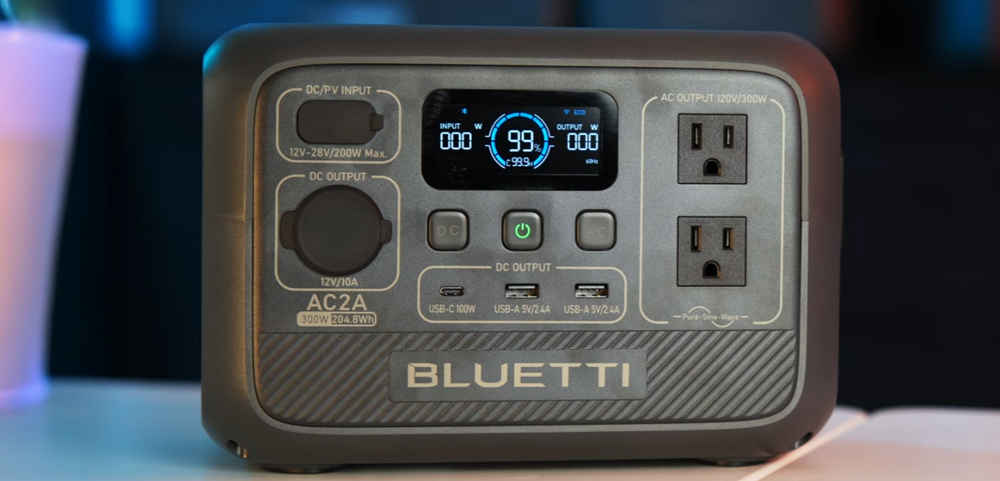
Our verdict:
Overall, we give the AC2A a B grade. Its main advantage is how small and light it is, and it does provide a great assembly of versatile ports, but it’s missing a light on the front, USB-C recharging, and a wireless charging pad, which used to be Bluetti’s signature touch.
At just 7.9 pounds, the AC2A is lightweight and ultra-portable. This capable little solar generator is a great upgrade from traditional power banks. It offers the flexibility of USB outputs as well as AC outputs, and can charge from small and light solar panels.
The AC2A can charge a smartphone 10 to 15 times, an iPad 6 to 7 times, a professional drone battery 4 to 5 times, or a full-sized laptop 2 to 3 times.
The AC2A can be recharged from up to 200 W of solar panels or up to 270 W of AC power from the wall. It does not charge from USB-C, which is a bit of a bummer.
Bluetti AC70
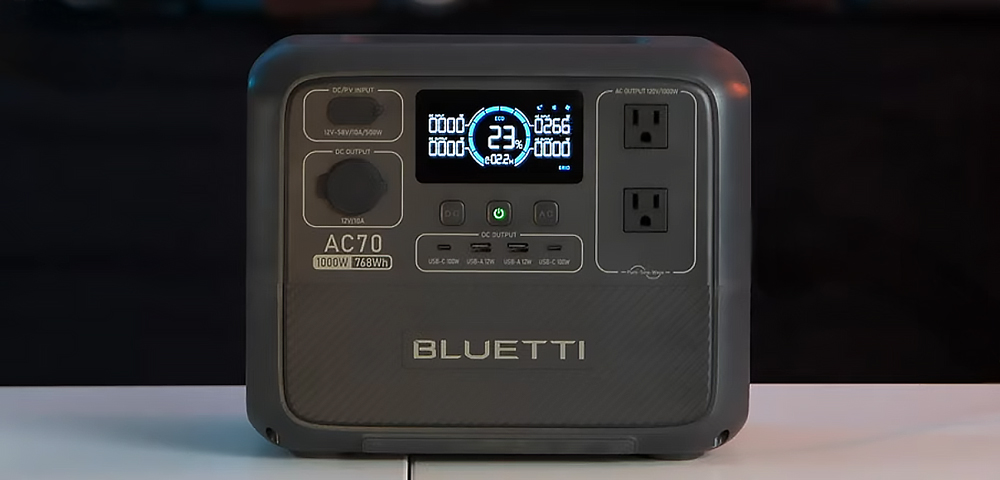
Our verdict:
Overall, we give the AC70 an A grade.
The AC70 is Bluetti’s 1 kW portable power station. This fills a niche that Bluetti didn’t have a good answer for until now. With 768Wh of energy storage and up to 2,000 watts of “Power Lifting Mode” output, this is a glamper’s new best friend.
It can keep all your devices charged and running, but more importantly, it can run a tea kettle at the full 1,500 watts (with Power Lifting mode) for those people who just need their pour-over coffee out in the wilderness.
You’d have to spend a lot more money to get a portable power station that’s much better than the AC70. Bluetti's own AC180 is the next step up, and tends to cost anywhere from $50 to $200 more.
Bluetti AC180
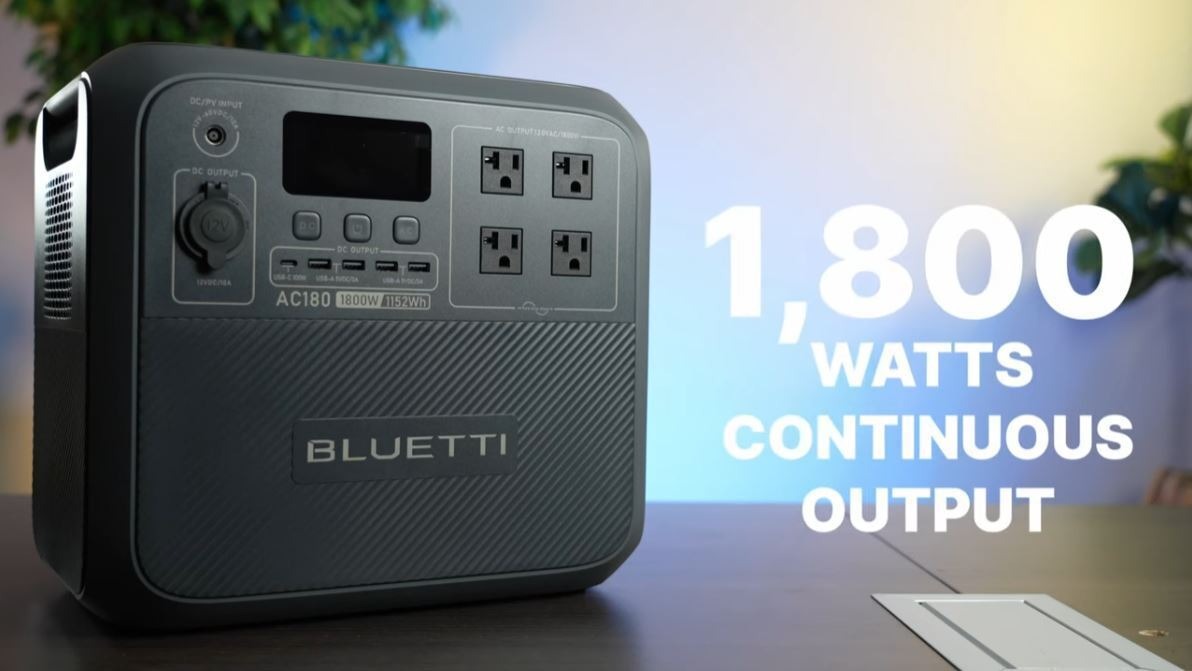
Our verdict
The AC180 knocks it out of the park and earns an A+. It’s perfectly portable, plenty powerful, and has all the ports you’ll need for most daily needs. At its frequent sale price of $499, it is a no-brainer power station.
At 35.6 pounds, it comes in a little heavier than Bluetti says on their website (32.6 lbs), but it’s still easy enough to grab and put in a vehicle.
With 1,152 Wh capacity and a continuous power output of 1,800 W, it can run basically all standard small appliances like coffee makers, hair dryers, microwaves, and space heaters. It can also act as an uninterruptible power supply to keep essential devices like modems, desktop computers, and CPAP machines running in the event of an outage.
In our testing, the AC180 had no problem heating up a tea kettle in under 4 minutes, heating food in a microwave, and playing video games on a Nintendo Switch and LED TV.
Bluetti Pioneer MD (AC180T)
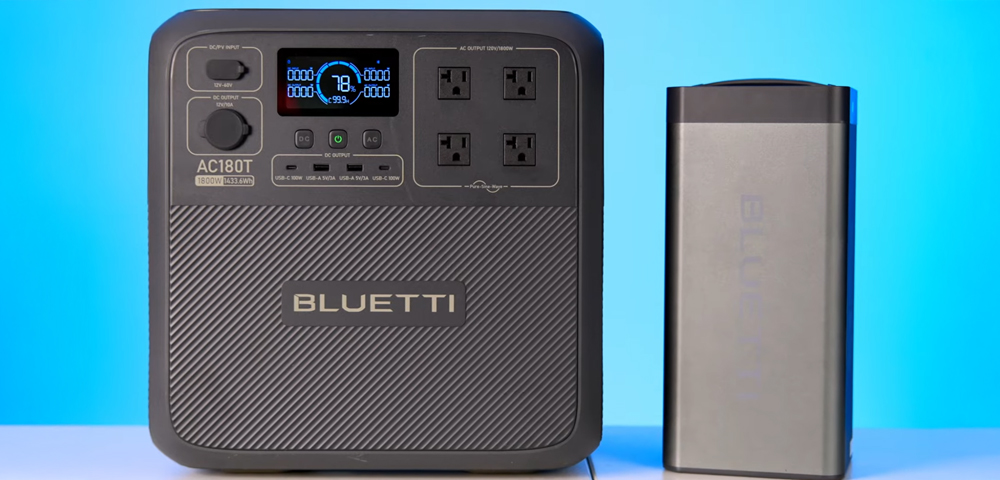
Our verdict
The AC180T gets a B grade from our testing team. It’s definitely a unique product, but the swappable batteries drive the price up a bit too high for our tastes. If you’re in the market for both a portable fridge AND a solar generator, this can be a good solution, but the sale price on the standard AC180 makes it a much more compelling buy.
Bluetti’s AC180T and MultiCooler are actually part of a new product ecosystem called SwapSolar. The idea is based on the concept of swappable batteries that can be charged inside a portable generator and then used in separate appliances like the new MultiCooler portable refrigerator/ice-maker combo.
The first generator in the new lineup is the Pioneer MD (AC180T). It comes with two swappable B70 batteries inside and is being sold alongside the MultiCooler now through Bluetti’s website for $1,799.
Extra B70 battery packs sell for a price of $399, which is just 56 cents per watt-hour, allowing you to expand your total energy storage for less than the purchase price of a second AC180T.
We tested out the SwapSolar combo shortly before launch. Here’s our video review of how it went:
How SwapSolar works
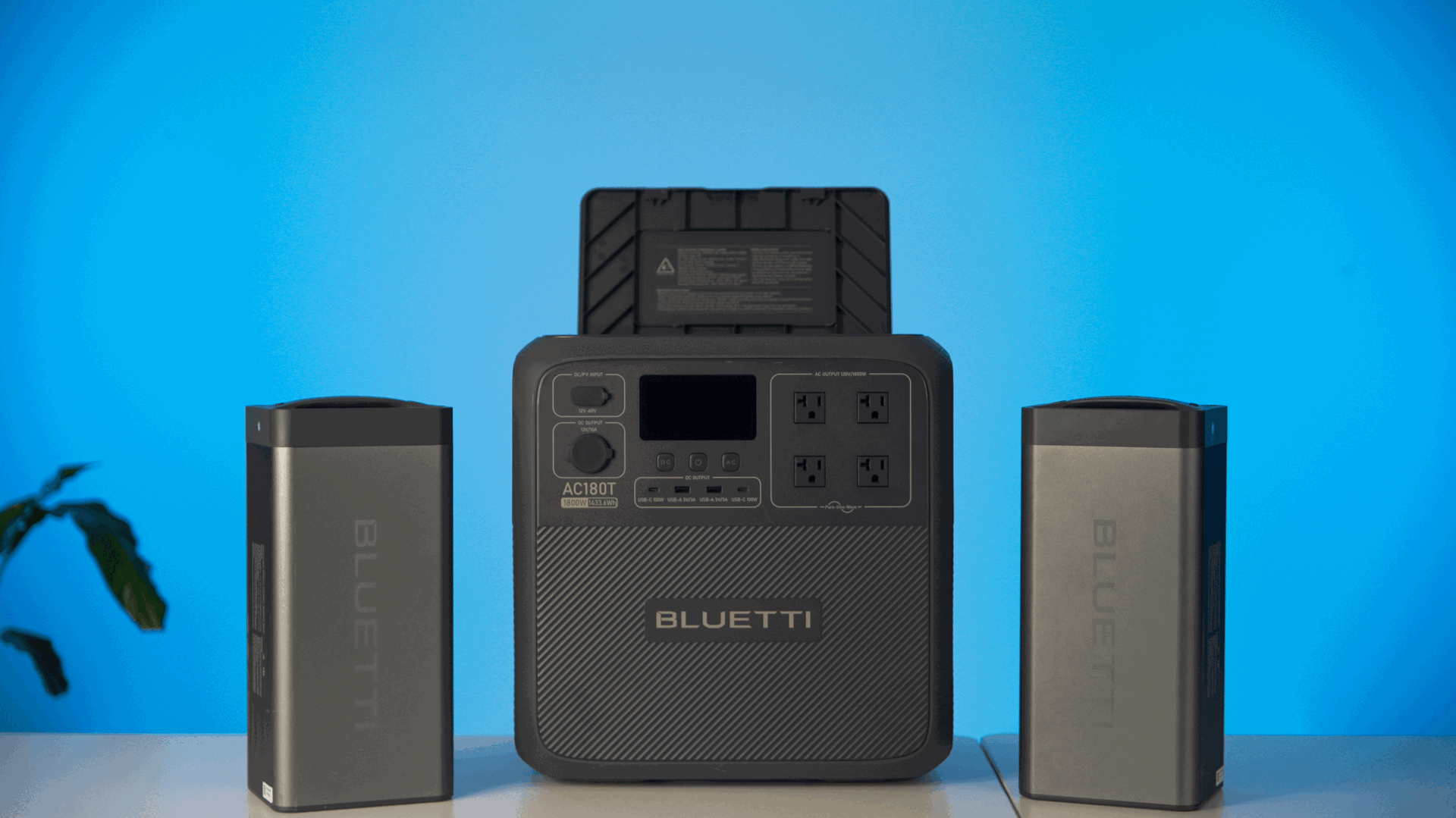
The benefits of the Bluetti SwapSolar setup are high power output, portability, expandability, and future-proofing. The first generator in the new lineup is the AC180T. It comes with two swappable B70 batteries inside and is being sold alongside the MultiCooler.
The AC180T boasts 1,200W of continuous output with one battery or 1,800W with two, which is enough to power most household appliances and electronics. The maximum output can be pushed to 2,700 W via “Power Lifting” mode for things like space heaters and electric tea kettles.
The AC180T is ultra-portable because the batteries can be removed for transportation, leaving the empty unit weighing just 25 pounds for easy carrying. Each B70 battery weighs 19 pounds and has a robust handle on top, making it simple to “swap” them when necessary.
When a battery is swapped, the AC180T keeps working as long as it has one battery installed, providing continuous power to your devices.
Future uses. Though the only current use for these batteries is to power the MultiCooler, you can set full batteries aside as extra storage. Future uses for the B70 could include running trolling motors for fishing or power outposts for camping. These deep-cycle batteries are meant for long-term storage and repeated charging, so they aren’t ideal for things like e-bikes or scooters, but don’t be surprised if a future iteration of this design is adapted for those uses.
Bluetti Elite 200 V2
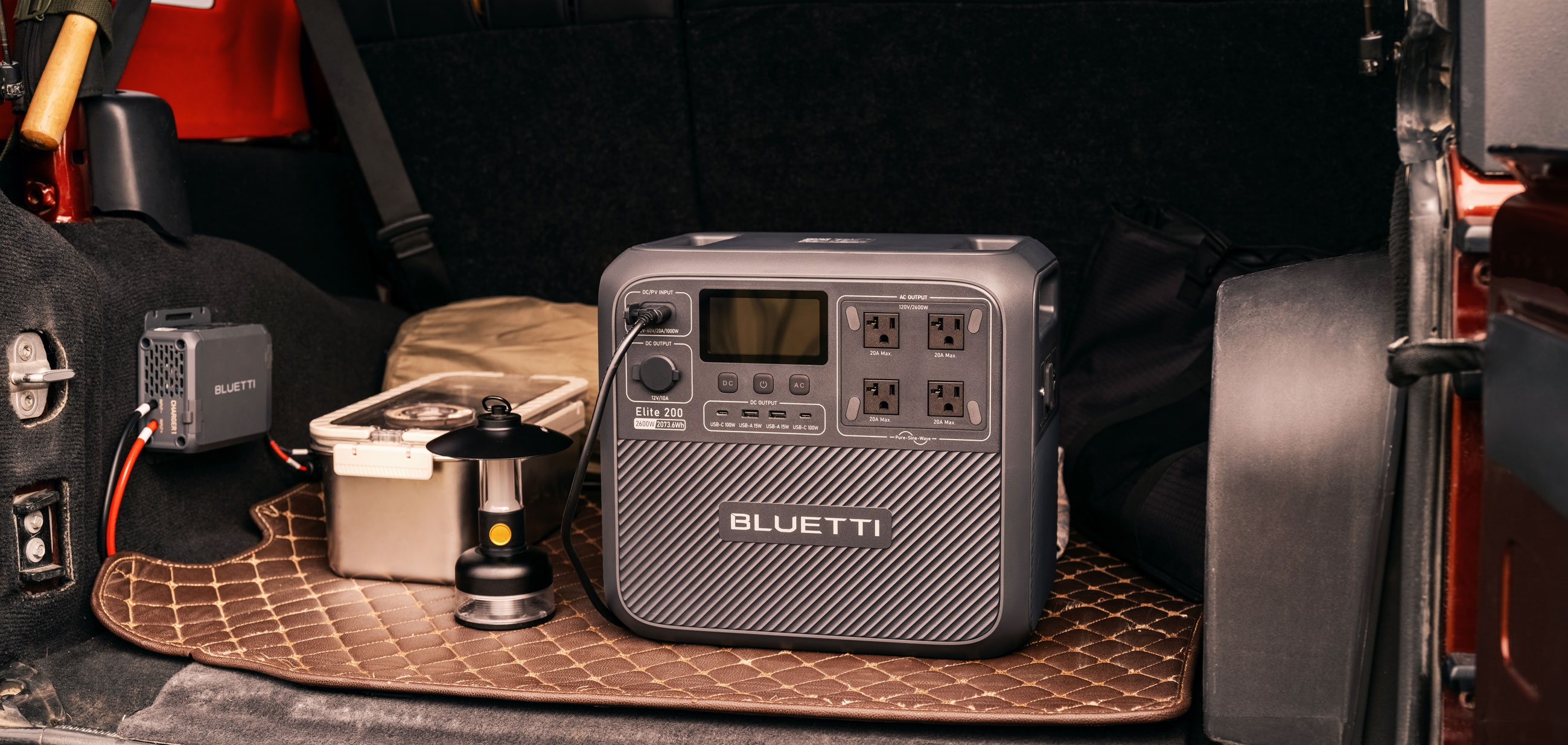
Image courtesy of Bluetti
Our verdict:
The Bluetti Elite 200 V2 was released in late 2024, marking an important shift in the company’s strategy. The Elite was the first Bluetti power station to use automotive-grade lithium iron phosphate battery cells, which made this power station the most compact, weight- and space-efficient one in Bluetti’s product lineup.
After we spent time testing it, it won our 2025 award for the best premium solar generator.
Bluetti Apex 300

Our verdict
The Apex 300 is Bluetti’s latest portable/home power station, and like the Elite 200 V2, it represents another shift in how the company does business—and not just because it uses the same automotive-grade battery cells that are rated for 6,000 charge-discharge cycles.
With its big power output, the Apex 300 can go from the campsite to the worksite, and slot right back into your home setup to provide emergency backup or peak shifting. One main feature of the Apex 300 ecosystem is expandability. A single unit can have up to six B300K batteries connected to it for a total of 19.4 kWh of storage. For the first time ever in a Bluetti battery, this expansion is done via a short, low-profile connector, far different from the company’s giant, unwieldy P090A Battery Expansion Cable.
The Apex 300 is more like the center of a modular ecosystem than it is a single product, and it can be customized with add-ons to make it work for lots of different kinds of people. These add-ons include a DC expansion hub and alternator charger kit for RV enthusiasts, and a distribution panel, AC hub, and solar interface for home users.
As far as off-grid solar goes, we haven’t had the chance to test the SolarX box or Hub A1 yet, but if they work as advertised, it may be the simplest way to set up a full-featured off-grid solar cabin, and we like that.
When it comes to home backup, we think that people who are serious should consider getting a professional installation of one of the best home battery backup systems, but we can’t argue that Bluetti’s piecemeal approach to assembling a home battery system provides much more flexibility to use the inverter in other ways.

Speaking of expansion, up to 3 units can be wired in parallel using Bluetti’s Hub A1, for a total of 11.52 kW of power output and 58 kWh of capacity. That’s as much power as a Tesla Powerwall 3, with over four times the storage capacity.
How does Bluetti compare to the competition?
Bluetti is among the best portable battery companies in the world. Its newest LFP battery cells are rated to last a bit longer than products from its main competitors, EcoFlow and Anker, and its products are every bit as durable and easy to use.
With 48 to 60-month warranties on its flagship products, Bluetti matches the best offerings of its main competitors and beats value brands that offer only 24 to 36-month coverage.
The company also offers many different products to fit many different needs, from the tiny AC2A up to the whole-home backup of the EP900 system. The one thing it doesn’t seem to offer is wheels, other than on its older EP500Pro unit.
Which Bluetti product is right for you?
If you're on the go and need to keep small appliances powered in an off-grid situation, the AC70 is an excellent choice. If you just want to keep your phone charged in the wilderness, the new EB3A is a great, inexpensive option.
For longer trips and cabin stays, the Elite 200 V2 provides a robust amount of energy storage and power output in a compact form factor, but if you’re planning your own permanent installation in an off-grid cabin, consider the Apex 300 ecosystem.
For home backup applications, we recommend the EP900 Home ESS because of the form factor and the 5-year warranty. If Bluetti ever increases its warranty protection for its modular batteries, we'll update that recommendation accordingly.
Bottom line: Are Bluetti products good?
Bluetti's batteries and solar panels compare favorably with the majority of other portable solutions on the market. Their LFP batteries and portable solar panels are powerful and well-built products designed for a life lived outside of the boundaries of the electric grid. On top of that, Bluetti meets or exceeds industry standards for portable devices with 3 to 5-year warranties on its products.
Bluetti has now been around for nearly a decade, and its portable batteries have proven to be as good as promised. The technology they use is solid, the products are proving popular and well-liked, and Bluetti reps actively engage customers through multiple channels, including an owners' Facebook group. The company seems to be doing things right.
A final caveat is that Bluetti's portable solar panels aren't as robust as actual home solar panels. For example, they aren't designed to be outside in the rain and snow. If you're looking for something to act as a fixture on your home or even off-grid cabin, real roof- or ground-mounted solar panels are much more robust and can survive the weather for decades. And you can still use Bluetti battery backup with a well-designed solar installation.

Regardless of the caveats, Bluetti is making some great products. If you’re looking for a way to keep important devices powered up while in the wilderness, Bluetti batteries and solar panels have our recommendation.
Ben Zientara is a writer, researcher, and solar policy analyst who has written about the residential solar industry, the electric grid, and state utility policy since 2013. His early work included leading the team that produced the annual State Solar Power Rankings Report for the Solar Power Rocks website from 2015 to 2020. The rankings were utilized and referenced by a diverse mix of policymakers, advocacy groups, and media including The Center...
Learn more about Ben Zientara